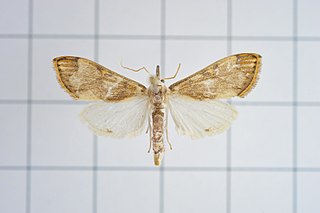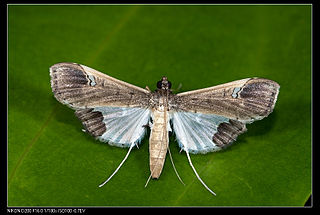
The Pyraloidea are a moth superfamily containing about 16,000 described species worldwide, and probably at least as many more remain to be described. They are generally fairly small moths, and as such, they have been traditionally associated with the paraphyletic Microlepidoptera.
Glauconoe is a genus of moths of the family Crambidae. It contains only one species, Glauconoe deductalis, which is found in Australia (Queensland), New Guinea, Sri Lanka and Taiwan.

Parapoynx fluctuosalis or Fluctuating China-mark or Waved China-mark, is a moth of the family Crambidae. It is a widespread species, known from Africa, India, Sri Lanka, China, Japan, Malaysia, Taiwan, Guam, Hawaii, Fiji, Australia and the Galápagos Islands. It is also an introduced species in Europe, where it has been recorded from Great Britain, the Iberian Peninsula and Sardinia.

Pyralis manihotalis is a moth of the family Pyralidae described by Achille Guenée in 1854.

Hypsopygia mauritialis is a moth of the family Pyralidae described by Jean Baptiste Boisduval in 1833. It is a widespread species, known from Africa, India, China, Malaysia, Taiwan, Japan, Australia and Hawaii.

Pyralis regalis is a species of snout moth. It is found from most of Europe east to Asia, including China, Cambodia, Myanmar, India, Russia, Korea, Japan and Taiwan.

Botyodes diniasalis is a species of moth in the family Crambidae. It is found on the Canary Islands, as well as in Taiwan, China, Japan and Russia. It has also been recorded from Mali, South Africa and the Himalaya.

Loryma recusata is a species of snout moth in the genus Loryma. It was described by Francis Walker in 1863 and is known from Taiwan, Indonesia, Sri Lanka, India, Thailand, western Malaysia and New Guinea. It has also been recorded from northern Australia and South Africa.

Scopariinae is a subfamily of the lepidopteran family Crambidae. The subfamily was described by Achille Guenée in 1854.

Gargela renatusalis is a moth in the family Crambidae. It was described by Francis Walker in 1859. It is found on Borneo, Java, Sri Lanka and Taiwan.
Surattha albistigma is a moth in the family Crambidae. It is found in Taiwan.
Preneopogon catenalis is a moth in the family Crambidae. It was described by Wileman in 1911. It is found in Japan and Taiwan.
Patissa fulvosparsa is a moth in the family Crambidae. It was described by Arthur Gardiner Butler in 1881. It is found in China, Taiwan, Japan, Korea, India and Indonesia.

Cirrhochrista fuscusa is a moth in the family Crambidae. It was described by Fu-Qiang Chen, Shi-Mei Song and Chun-Sheng Wu in 2006. It is only found in Taiwan.

Herpetogramma luctuosalis is a moth in the family Crambidae. It was described by Achille Guenée in 1854. It is found in Siberia, Malaysia, India, Taiwan and China.

Maruca amboinalis is a moth in the family Crambidae. It was described by Cajetan von Felder, Rudolf Felder and Alois Friedrich Rogenhofer in 1875. It is found in Indonesia, Taiwan and Japan.
Mecyna gracilis is a moth in the family Crambidae. It was described by Arthur Gardiner Butler in 1879. It is found in the Russian Far East, Japan, Taiwan and China.
Mecyna tricolor is a moth in the family Crambidae. It was described by Arthur Gardiner Butler in 1879. It is found in Japan, Taiwan, China and Russia.
Palpita homalia is a moth in the family Crambidae. It was described by Inoue in 1996. It is found in Japan and Taiwan.

Udea stigmatalis is a moth in the family Crambidae. It was described by Wileman in 1911. It is found in Japan, Taiwan and Russia.












